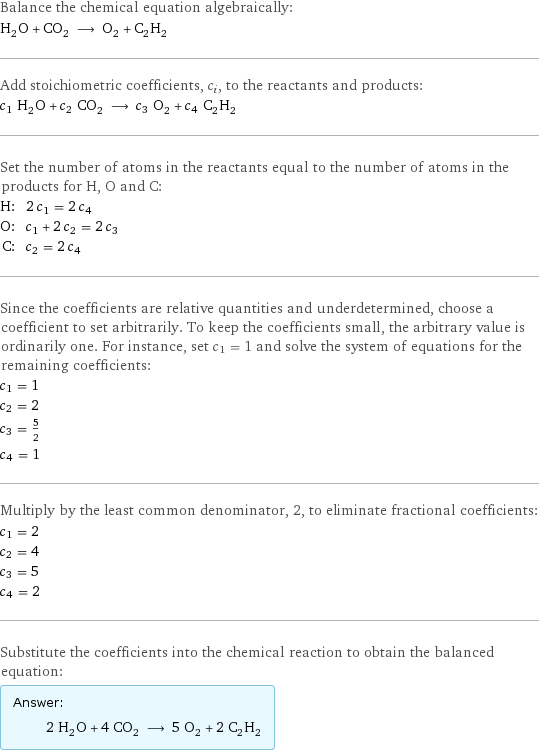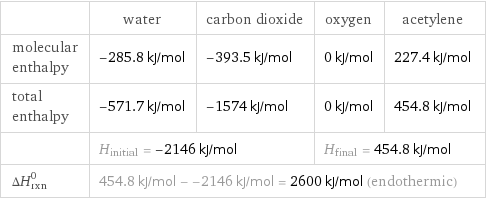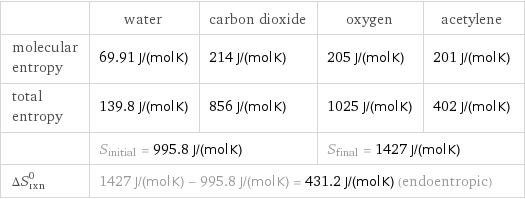Input interpretation

H_2O water + CO_2 carbon dioxide ⟶ O_2 oxygen + C_2H_2 acetylene
Balanced equation

Balance the chemical equation algebraically: H_2O + CO_2 ⟶ O_2 + C_2H_2 Add stoichiometric coefficients, c_i, to the reactants and products: c_1 H_2O + c_2 CO_2 ⟶ c_3 O_2 + c_4 C_2H_2 Set the number of atoms in the reactants equal to the number of atoms in the products for H, O and C: H: | 2 c_1 = 2 c_4 O: | c_1 + 2 c_2 = 2 c_3 C: | c_2 = 2 c_4 Since the coefficients are relative quantities and underdetermined, choose a coefficient to set arbitrarily. To keep the coefficients small, the arbitrary value is ordinarily one. For instance, set c_1 = 1 and solve the system of equations for the remaining coefficients: c_1 = 1 c_2 = 2 c_3 = 5/2 c_4 = 1 Multiply by the least common denominator, 2, to eliminate fractional coefficients: c_1 = 2 c_2 = 4 c_3 = 5 c_4 = 2 Substitute the coefficients into the chemical reaction to obtain the balanced equation: Answer: | | 2 H_2O + 4 CO_2 ⟶ 5 O_2 + 2 C_2H_2
Structures

+ ⟶ +
Names

water + carbon dioxide ⟶ oxygen + acetylene
Reaction thermodynamics
Enthalpy

| water | carbon dioxide | oxygen | acetylene molecular enthalpy | -285.8 kJ/mol | -393.5 kJ/mol | 0 kJ/mol | 227.4 kJ/mol total enthalpy | -571.7 kJ/mol | -1574 kJ/mol | 0 kJ/mol | 454.8 kJ/mol | H_initial = -2146 kJ/mol | | H_final = 454.8 kJ/mol | ΔH_rxn^0 | 454.8 kJ/mol - -2146 kJ/mol = 2600 kJ/mol (endothermic) | | |
Gibbs free energy

| water | carbon dioxide | oxygen | acetylene molecular free energy | -237.1 kJ/mol | -394.4 kJ/mol | 231.7 kJ/mol | 209.9 kJ/mol total free energy | -474.2 kJ/mol | -1578 kJ/mol | 1159 kJ/mol | 419.8 kJ/mol | G_initial = -2052 kJ/mol | | G_final = 1578 kJ/mol | ΔG_rxn^0 | 1578 kJ/mol - -2052 kJ/mol = 3630 kJ/mol (endergonic) | | |
Entropy

| water | carbon dioxide | oxygen | acetylene molecular entropy | 69.91 J/(mol K) | 214 J/(mol K) | 205 J/(mol K) | 201 J/(mol K) total entropy | 139.8 J/(mol K) | 856 J/(mol K) | 1025 J/(mol K) | 402 J/(mol K) | S_initial = 995.8 J/(mol K) | | S_final = 1427 J/(mol K) | ΔS_rxn^0 | 1427 J/(mol K) - 995.8 J/(mol K) = 431.2 J/(mol K) (endoentropic) | | |
Equilibrium constant
![Construct the equilibrium constant, K, expression for: H_2O + CO_2 ⟶ O_2 + C_2H_2 Plan: • Balance the chemical equation. • Determine the stoichiometric numbers. • Assemble the activity expression for each chemical species. • Use the activity expressions to build the equilibrium constant expression. Write the balanced chemical equation: 2 H_2O + 4 CO_2 ⟶ 5 O_2 + 2 C_2H_2 Assign stoichiometric numbers, ν_i, using the stoichiometric coefficients, c_i, from the balanced chemical equation in the following manner: ν_i = -c_i for reactants and ν_i = c_i for products: chemical species | c_i | ν_i H_2O | 2 | -2 CO_2 | 4 | -4 O_2 | 5 | 5 C_2H_2 | 2 | 2 Assemble the activity expressions accounting for the state of matter and ν_i: chemical species | c_i | ν_i | activity expression H_2O | 2 | -2 | ([H2O])^(-2) CO_2 | 4 | -4 | ([CO2])^(-4) O_2 | 5 | 5 | ([O2])^5 C_2H_2 | 2 | 2 | ([C2H2])^2 The equilibrium constant symbol in the concentration basis is: K_c Mulitply the activity expressions to arrive at the K_c expression: Answer: | | K_c = ([H2O])^(-2) ([CO2])^(-4) ([O2])^5 ([C2H2])^2 = (([O2])^5 ([C2H2])^2)/(([H2O])^2 ([CO2])^4)](../image_source/cdd2040a60b6f06194b12eb0c76f8b5c.png)
Construct the equilibrium constant, K, expression for: H_2O + CO_2 ⟶ O_2 + C_2H_2 Plan: • Balance the chemical equation. • Determine the stoichiometric numbers. • Assemble the activity expression for each chemical species. • Use the activity expressions to build the equilibrium constant expression. Write the balanced chemical equation: 2 H_2O + 4 CO_2 ⟶ 5 O_2 + 2 C_2H_2 Assign stoichiometric numbers, ν_i, using the stoichiometric coefficients, c_i, from the balanced chemical equation in the following manner: ν_i = -c_i for reactants and ν_i = c_i for products: chemical species | c_i | ν_i H_2O | 2 | -2 CO_2 | 4 | -4 O_2 | 5 | 5 C_2H_2 | 2 | 2 Assemble the activity expressions accounting for the state of matter and ν_i: chemical species | c_i | ν_i | activity expression H_2O | 2 | -2 | ([H2O])^(-2) CO_2 | 4 | -4 | ([CO2])^(-4) O_2 | 5 | 5 | ([O2])^5 C_2H_2 | 2 | 2 | ([C2H2])^2 The equilibrium constant symbol in the concentration basis is: K_c Mulitply the activity expressions to arrive at the K_c expression: Answer: | | K_c = ([H2O])^(-2) ([CO2])^(-4) ([O2])^5 ([C2H2])^2 = (([O2])^5 ([C2H2])^2)/(([H2O])^2 ([CO2])^4)
Rate of reaction
![Construct the rate of reaction expression for: H_2O + CO_2 ⟶ O_2 + C_2H_2 Plan: • Balance the chemical equation. • Determine the stoichiometric numbers. • Assemble the rate term for each chemical species. • Write the rate of reaction expression. Write the balanced chemical equation: 2 H_2O + 4 CO_2 ⟶ 5 O_2 + 2 C_2H_2 Assign stoichiometric numbers, ν_i, using the stoichiometric coefficients, c_i, from the balanced chemical equation in the following manner: ν_i = -c_i for reactants and ν_i = c_i for products: chemical species | c_i | ν_i H_2O | 2 | -2 CO_2 | 4 | -4 O_2 | 5 | 5 C_2H_2 | 2 | 2 The rate term for each chemical species, B_i, is 1/ν_i(Δ[B_i])/(Δt) where [B_i] is the amount concentration and t is time: chemical species | c_i | ν_i | rate term H_2O | 2 | -2 | -1/2 (Δ[H2O])/(Δt) CO_2 | 4 | -4 | -1/4 (Δ[CO2])/(Δt) O_2 | 5 | 5 | 1/5 (Δ[O2])/(Δt) C_2H_2 | 2 | 2 | 1/2 (Δ[C2H2])/(Δt) (for infinitesimal rate of change, replace Δ with d) Set the rate terms equal to each other to arrive at the rate expression: Answer: | | rate = -1/2 (Δ[H2O])/(Δt) = -1/4 (Δ[CO2])/(Δt) = 1/5 (Δ[O2])/(Δt) = 1/2 (Δ[C2H2])/(Δt) (assuming constant volume and no accumulation of intermediates or side products)](../image_source/8713c75b2e0a7ee7c65a69022d28a8b4.png)
Construct the rate of reaction expression for: H_2O + CO_2 ⟶ O_2 + C_2H_2 Plan: • Balance the chemical equation. • Determine the stoichiometric numbers. • Assemble the rate term for each chemical species. • Write the rate of reaction expression. Write the balanced chemical equation: 2 H_2O + 4 CO_2 ⟶ 5 O_2 + 2 C_2H_2 Assign stoichiometric numbers, ν_i, using the stoichiometric coefficients, c_i, from the balanced chemical equation in the following manner: ν_i = -c_i for reactants and ν_i = c_i for products: chemical species | c_i | ν_i H_2O | 2 | -2 CO_2 | 4 | -4 O_2 | 5 | 5 C_2H_2 | 2 | 2 The rate term for each chemical species, B_i, is 1/ν_i(Δ[B_i])/(Δt) where [B_i] is the amount concentration and t is time: chemical species | c_i | ν_i | rate term H_2O | 2 | -2 | -1/2 (Δ[H2O])/(Δt) CO_2 | 4 | -4 | -1/4 (Δ[CO2])/(Δt) O_2 | 5 | 5 | 1/5 (Δ[O2])/(Δt) C_2H_2 | 2 | 2 | 1/2 (Δ[C2H2])/(Δt) (for infinitesimal rate of change, replace Δ with d) Set the rate terms equal to each other to arrive at the rate expression: Answer: | | rate = -1/2 (Δ[H2O])/(Δt) = -1/4 (Δ[CO2])/(Δt) = 1/5 (Δ[O2])/(Δt) = 1/2 (Δ[C2H2])/(Δt) (assuming constant volume and no accumulation of intermediates or side products)
Chemical names and formulas

| water | carbon dioxide | oxygen | acetylene formula | H_2O | CO_2 | O_2 | C_2H_2 name | water | carbon dioxide | oxygen | acetylene IUPAC name | water | carbon dioxide | molecular oxygen | acetylene